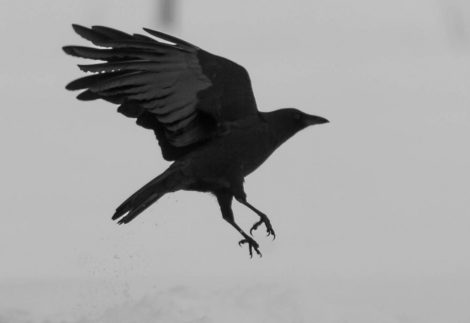
The keeper of secrets and mysteries, the Crow/Raven is a totem that often works as a messenger of the gods and guide into the unknown.
Photo: Flickr.
In the introductory article: Totems, familiars, power animals and where to find them, I’ve mentioned that my native totem is the Raven. After writing about the Owl and the Fox as spirit animals, it is only appropriate to address this mysterious spirit animal that is the Crow or the Raven and to help you understand it better. In the same article, I’ve also mentioned that a totem is representative of its entire genus, it’s not divided into species and individual animals.
That is why I will address both species of birds as one. In fact, they are pretty much the same, both are in the family Corvidae and their genus is widely referred to as Corvus. There is no consistent distinction between ravens and crows, other than size – generally, crows are smaller than ravens. Furthermore, there is no consistent distinction between them metaphysically or spiritually. However, in Romania ravens are protected by law and tend to live closer to the mountains, while crows can be found in any area of the country.

Sigil made by Radiana Piț on the cover of her book, Yearning for Spirit. Her native totem, the Crow-Raven and that of her Daco-Thracian ancestors, the Wolf, are depicted together in order to represent the symbiotic relationship between the two totems | Instagram: @crowhag
The Crow or the Raven is incredibly important to me personally and to my own Work. As I’ve previously said, your totem is an extension of who you are, an archetype. I’ve embraced the raven as such and its presence can be seen throughout my work, from my avatar as Crowhag, to the sigil present on the cover of my book “Yearning for Spirit”, where I refer to the symbiotic relationship between the Raven (Crow) and the Wolf, the totem of my Daco-Thracian ancestors.
Rightfully so, Carl Jung associated the Raven with the archetype of the Shadow, the “dark side” of our psyche. It is representative of the unconscious, its depths, darkness, and power. Our Shadow, our Raven, must be integrated to fully allow ourselves to be in touch with our most inner self. In this regard, the raven is very much a symbol of the inner truth.
In universal mythology, the raven is seen both as a solar hero and psychopomp – messenger of death. In some instances, the dark bird is even seen as a manifestation of the Demiurge. He is a keeper of the Great Mysteries, one that – as opposed to other spirit animals – is not empowered by its ability to see in the dark, but its ability to become the darkness itself.
Much of the respect and fascination with the dark bird stems from the “Icarus aspect” within every human being. The desire to rise above the mortal plane, to fly, to soar freely and to touch the divine is what makes mortals admire the raven or the crow and invest it with the functions of a messenger for the gods. It is the same thing that makes them fear the bird.
Its secret knowledge is forbidden to man and its connection to the afterlife can be scary. That is why it became a symbol of the macabre, of death, destruction, war, and a bearer of darkness and shadow. Regardless, Corvus is a symbol for the superior states of being.
The mythos around the dark bird has roots in reality. Ravens and crows are possibly the smartest birds on Earth and their exceptional intelligence makes them outstanding. While they tend to be solitary beings in the animal kingdom, with the exception of their connection to the wolf, crows are able to create bonds with humans and of adapting their language intentionally, and not out of reflex. They are also able to create tools for themselves, to understand, to develop strategies, and they are capable of other cognitive processes as well.
Crows and Ravens – The Genus »Corvus« as Spirit Animal

As a spirit animal, the crow or the raven conveys messages from the spiritual realms and it is often representative of the souls of the dead. Photo: Flickr
The Raven, also known as the “Keeper of Secrets” is the messenger between heaven and earth, the dead and the living, man and gods. When a raven or a crow flies into your life, they warn you of imminent change. And because they are masters of synchronicity, they bring with them the power to bend time and space, thus creating the perfect “right place at the right time” situation.
The dark bird is also creating the perfect context for emergence. You might expect a multitude of aspects in your life to intermingle in the dark and come forth into the light as one. Through dreams, the raven or the crow can help you discover secrets that are being kept from you, as well as repressed aspects of yourself that you need to handle.
Ultimately, when the crow or raven flies into your life, it is there to help you discover your inner truth and become more self-aware. It symbolizes the depths of your unconscious and it guides you through it. It is there to help you untangle the knots woven into your life and reveal your inner self. A crow usually appears on its own and it rarely responds when being summoned. That is because the raven or the crow only shares its knowledge with those worthy of it.
Corvus Lore
The symbol of the Raven (Crow) dates from the Paleolithic age when many corvids circled around human encampments and followed the hunters to gather the scraps. The corvids were seen as the Prehistoric’s man connection to divinity and the afterlife, and this perception hasn’t changed much throughout time. The bird is still an archetype of elevation, of the desire and will to rise towards the absolute in the limitless sky. The raven or the crow was and still is a universal metaphor for the soul.
People have always banished crows and ravens out of fear of what they may convey. They were always considered jinxes and death omens. Because of their association with death, they became known as funeral messengers. While they are universally seen as such, this is not at all what they are reduced to. The crow or the raven is believed to actively seek the death of its prey and this is because of the symbiotic relationship it has with the wolf in nature.
Their social attachment helps them feed on the same prey and survive in harmony. One alerts the other about prey and that is why it is believed that ravens call their “wolf-birds”, as they are nicknamed, in order to kill for food. We cannot judge nature for being natural, but this lack of control over nature is what made the ancient man feel powerless when faced with the raven’s ability of “conjuring” death.
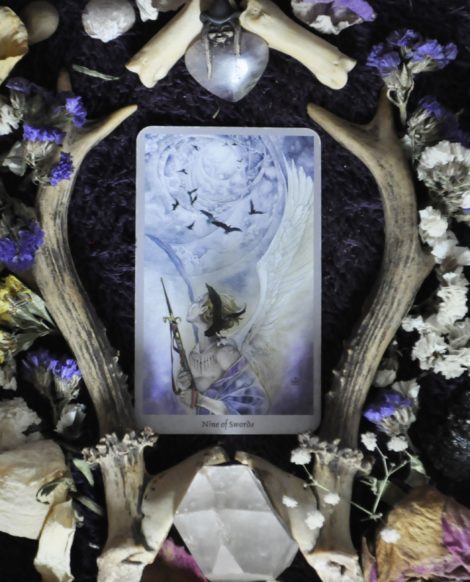
Nine of Swords from the Shadowscapes Tarot: “Stormcrows herald impending dissolution with voices cawing raucous absolution, round and round and spiraling ever near, one future sought – one future feared.” | Photo by Radiana Piț, Instagram: @crowhag
It is pretty self-explanatory that the raven is an Air element and it is universally seen as such. It often correlates to the Swords in the Shadowscapes Tarot, and some associate it with water as well. According to Agrippa’s “De Occulta Philosophia”, a raven is a familiar
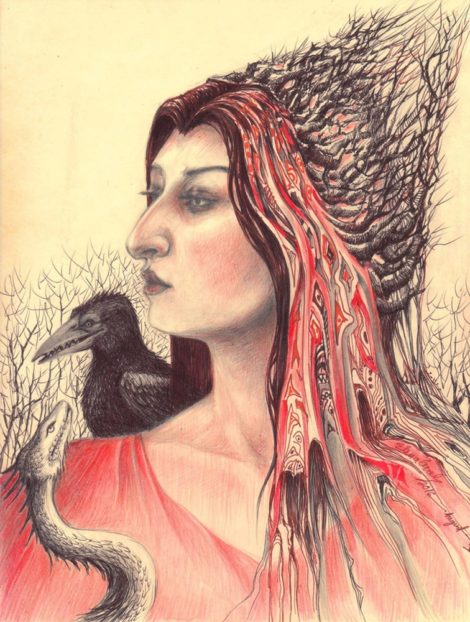
A portrait of Radiana Piț made by artist Elena Cercel. The totem of the Crow-Raven is depicted as a prehistoric entity, having teeth and a saurian appearance. One interpretation of the totems in this portrait can suggest a correlation to the Abrahamic interpretations of the black crow, who once was a white dove.
form of the spirit of Mars, which ties it to fire as an element.
The Raven is also the symbol of A’arab Zaraq – »Ravens of Dispersion”, also known as Harab Serapel – »Ravens of the Burning God«. A’arab Zaraq is the Qliphothic counterpart of the Sephirah Netzach on the Tree of Life. The Ravens of Dispersion are often depicted as demon-headed ravens that emerge from a volcano.
Here, the raven is the dark counterpart of the white dove and it represents war, storm, passion, sin, and forbidden wisdom. It is also seen as the Raven of Death that feeds off of the fallen ones on the battlefields – this alone evokes the image of the plague doctors in the Middle Ages. On the same note, the raven is a metaphor for the soul of a dark mage.
In the Hebrew Talmud, ravens are credited for teaching mankind funeral rites. When Cain slew Abel, it was a raven that showed Adam and Eve how to bury their son, thus marking the first burial. In the Qur’an’s version of the story, the raven taught Cain how to bury his brother. Christian and Hebrew superstitions regarding the raven also arose from the Great Flood myth in order to explain the raven’s failure to return with news of dry land after the flood and to justify the misconceptions surrounding the bird.
Noah sent a raven to search for dry land, but the raven forgot to return. It is suggested that the raven did not return because it was busy feasting upon the carrion left behind by the deluge. That is why Noah cursed the bird to change its plumage from white to black, to only eat carrion until the end of time, and its chicks to hatch only during the coldest of days. Much of this mythos has inspired “Crow: From the Life and Songs of the Crow” by Ted Hughes, which is wonderfully depicting the often misunderstood, innocent, and powerful Crow. However, many have still perceived this masterpiece as an attack on Christianity. But, as my favorite poem from the book, “Crow’s Theology”, reads:
»Crow realized there were two Gods-
One of them much bigger than the other
Loving his enemies
And having all the weapons«
Ted Hughes – »Crow’s Theology«
Nevertheless, in the same Abrahamic context, the raven seems to have a redeeming quality. As the legend goes, a small group of ravens was once ordered by God to feed Saint Elijah. The Ravens brought the saint bread, meat, and fresh water in the morning and evening. These Abrahamic legends are also present in Romanian folklore alongside other pre-Christian legends. And perhaps because of the syncretism, there are some superstitions in Romanian folklore that exhibit both fear and great respect for the sacred bird.
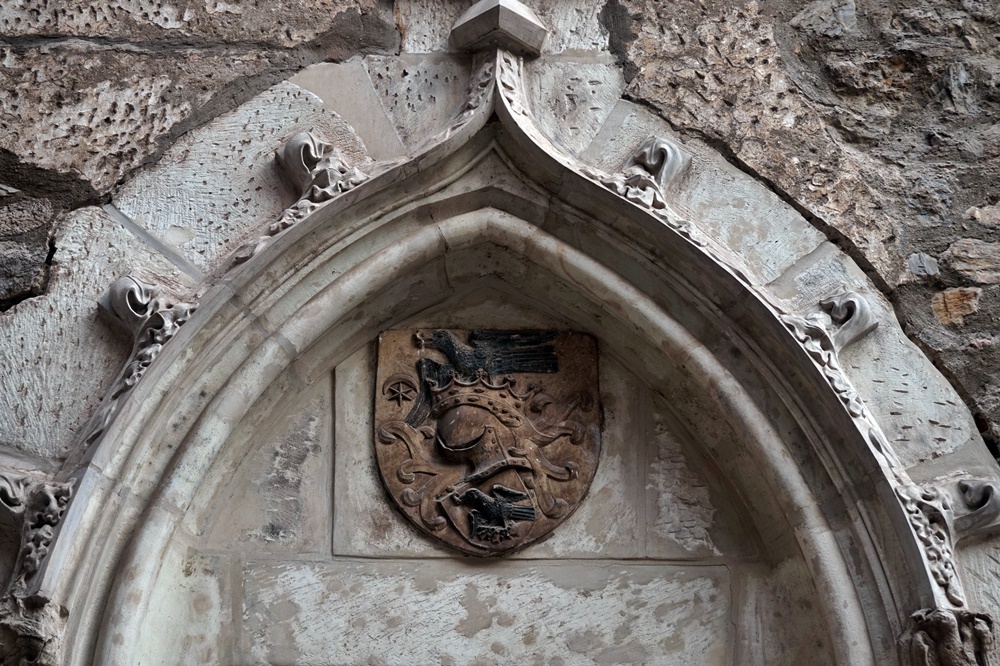
Inside the Corvin Castle of the Hunyadi family, built in the 15th century in Transylvania – It is said that the Raven became the noble family’s symbol after a raven stole a golden ring from Iancu of Hunedoara. Iancu, who is a prominent figure in Romanian history, was the illegitimate son of Sigismund of Luxemburg, king of Hungary, and he was given the golden ring at birth so he would be recognized by the king. A raven stole his ring when he was a child, and Iancu is said to have shot an arrow through the raven’s heart to recover the ring. It was then that he decided the raven would become his symbol and the descendants of his noble house inherited it from him. | Photo by Radiana Piț, Instagram: @crowhag
It is said that if you kill a raven or a crow, the village will be hit by hail. If someone kills a crow chick, the crops will be hit by drought. The bird is sanctified by the symbol of the cross on the roof of its beak, which makes it both a messenger of the gods and a funeral bird in Romanian lore. This is why the bird must be respected and protected. Hurting a crow or a raven means hurting the entire community, the village and everyone in it. The symbol of the Raven can also be found in the legends and coat of arms of the Corvin family, one of the most important noble houses in Transylvanian history.
Because the dark birds have been known since ancient times to be smart and to sometimes even be able to “talk”, they were invested with the power of prophecy and wisdom. However, ancient Egyptians and Hebrews believed that the dark bird was evil, especially because it was often seen plucking the eyes out of dead bodies. In the Mahabharata crows and ravens are also believed to be the messengers of death. For the Celts, however, the raven or the crow was a symbol of war, fertility, and prophecy.
The Irish associated it with the war goddess Babd who was also known as Babd Catha (»battle crow«), who was often the physical embodiment of the goddess. Babd is one of the three aspects of Mórrígan, the great phantom queen, goddess of war and fate. Crows and ravens also play a key role in »The Dream of Rhonabwy«, when Owain orders his ravens to attack Arthur’s army. In Norse mythology, Huginn (»thought«) and Muninn (»memory” or “mind«) are Odin’s (Wotan) ravens that fly all over Midgard, and act as his eyes. This is symbolic of shamanic practice.
Similarly to the shamanic practice suggested by Huginn and Muninn, the same is suggested through the raven’s role as a protector and teacher of seers. The witches and magicians who have developed their clairvoyant abilities were believed to have been able to transform into a crow to escape their enemies.
In Greek and Roman mythology, the raven was positively associated with longevity, fertility, hope, and the Sun, while simultaneously being associated with death. Crows and Ravens were seen as the messengers of the god of truth, prophecy, and the Sun god, Apollo. According to Strabo, the messengers of the gods with prophetic powers, ravens, were those who established the center of the world at Delphi. According to Greek tradition, ravens have also predicted Plato’s death.

Mural from the Korean Goguryeo period of the Three-Legged Crow flanked by a dragon and a phoenix, also known as Samjok-o in Korea. The solar bird is believed to be superior to both the dragon and the phoenix.
In China and Japan, the dark bird is a symbol of love, loyalty, and gratitude towards the family. Furthermore, the spirit of this bird was honored as a solar hero that moved the Sun and purged the Earth after the war has ended. The Three-Legged Crow found in the Eastern Asian myths is a representation of Yang, because of it’s ability to animate the Sun and bring light to mankind.
According to tradition, the three legs correspond to the three phases of the sun: dawn, zenith, dusk. Similar to the legend of the crow as a solar hero, the Hopi, Navajo, and Zuni believe that the world would still be immersed in darkness if the Crow wouldn’t have emerged from the dark womb of the universe. Other Native American tribes believe that the Crow is a physical manifestation of the Great Spirit who once helped create the Dark Mother, the Earth.
We can’t discuss Raven lore without at least mentioning the most famous poem about the dark bird. The mythos of the raven has never before been more beautifully depicted in one single poem. Besides the mythos, we see the Raven as an archetype in Edgar Allan Poe’s “The Raven”:
“And his eyes have all the seeming of a demon’s that is dreaming,
And the lamp-light o’er him streaming throws his shadow on the floor;
And my soul from out that shadow that lies floating on the floor
Shall be lifted – nevermore!”Edgar Alen Poe – »The Raven«
Here, the dark bird is a metaphor of his own shadow, echoing his fears, while simultaneously being a prophet, a messenger of the divine, and a “Raven of Dispersion”. Through the raven’s repetition of the word “nevermore” as an answer to all inquiries, we sense it’s unmovable stance, the darkest truth, and even a little bit of a trickster quality that emerges only as a result of the reactions its partner in conversation has.
Besides E.A. Poe’s “The Raven”, another endearing representation of the spirit of the raven is the one found in George R.R. Martin’s “A Song of Ice and Fire”. In that universe, the greenseers could speak and see through the birds which are able to speak the True Tongue, that of the children of the forest. In the Iron Islands, they are believed to be servants of the Storm God, and in the Faith of the Seven, it is said that the first raven came to the world when “the Crone peered through the door of death”.
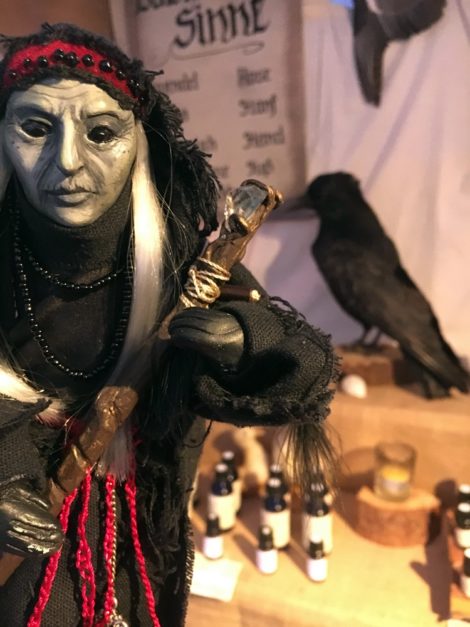
Nettle in the presence of the Raven, the keeper of mysteries. Photo by Nettle’s Garden, Instagram: @nettlesgarden
This spirit is personified through the Three-Eyed Crow and the Crows of the Night’s Watch or the “black brothers”. The Three-Eyed Crow or the Three-Eyed Raven is, in fact, a spirit that becomes the extension of its greenseer vessels. It is passed down from one greenseer to another, but it is a unique role. We see that through the former Three-Eyed Raven: Lord Bloodraven. He appears in dreams to Bran Stark and nurtures him into becoming the last greenseer, the next Three-Eyed Raven after he passes.
This is also a testimony to the spirit of the crow that comes as a messenger in dreams and who only passes its knowledge to those worthy of it. The Night’s Watch, however, is a testimony to other aspects of the dark bird: solitary, outcast, banished, messenger of death and destruction. The men of the Night’s Watch “take the black”, they become ascetic and become crows of the military order that dedicates itself to holding the Wall, to protect the realm from what lies beyond it.
Through this entire mythos and even through its presence in »A Song of Ice and Fire«, the raven-crow is here to remind us that it never left. It is not only a totem, an archetype, or a symbol. It is a condition of being that we can only perceive through the mythical phenomena and physical manifestations it has.
Despite its power and knowledge of all things hidden, the Crow is a modest spirit who cleans up after the wars and battles of humans, who is often shunned and banished. On this note, I’ll leave you with the words of the powerful Three-Eyed Crow: “I have been watching you. All of you. All of your lives, with a thousand eyes and one.”

www.Nettlesgarden.com – The Old Craft








Raven | April 18, 2018
|
Fabulous writing.
Immense Gratitude
Radiana Piț | April 18, 2018
|
Thank you kindly! I am glad you enjoy it. 🙂
Jon Bradshaw | April 18, 2018
|
Outstanding piece of work, Radiana! Thank you.
Radiana Piț | April 18, 2018
|
I am glad you think so! Thank you for your kind words. 🙂
Philip Floyd | May 8, 2019
|
I love this. So many un-asked and un-answered questions resolved. I went searching for knowledge and my corvid guides provided, thru you. Thank you for sharing this with the world.
Louise Ceres | February 23, 2020
|
Last night I dreamed I healed/ brought back a badly injured raven from the brink of death. It had a wound in it’s right side and it’s left wing was broken and almost featherless.
I took it to the top of some cliffs and sat with it inside a crucible of black where I protected it until it came too. We were surrounded by other Raven’s and a dog I walk for a friend was there too, in what I think was a supporting role.
I left and turned round to see the cliffs populated with large Ravens that were all looking at me, when I tried to return to see if the bird was fully recovered I couldn’t.
I found this article to be the most useful narrative on understanding what I was part of last night. I wasn’t afraid at anytime, but felt like I was in an alchemical situation, and that I revered these birds. Which I do in my waking state anyway. Thank you Raidiana.
MandaLeigh | February 25, 2021
|
Liked your use of so many different cultural stories. But you left out the symbiotic relationship these birds have with the wolf/coyote. The bird and dog are often seen hunting and eating together. Together they help guide souls to the lights and the path’s made by the Celestials incarnate. The dog was given the job of a companion and to protect the physical. The crow/raven and other multidimensional animals protect the auric spirit and soul.
Annette | October 21, 2021
|
I have been doing some research on crow/raven symbolism and this article is by far the best one I’ve come across. Thank you for being so thorough and pulling info from such widespread sources together into one cohesive whole.
Bran Wildes | January 12, 2022
|
I enjoyed reading this immensely, and am thankful you chose to share this part of your experience. I originally cane here while searching for differences between Raven and Crow people; and your perspective that they are essentially one and the same presents the possibility of a simple answer. As a token of my thanks for this, I’ll share my own favorite Raven quote 🙂
“I am a black bird, a Raven, I am Raven. I know and I am knowing—I know and see life and death, expansion and contraction and I do not shiver and cry—I am unafraid.
I am Raven. I am black as liquid night with wings and my eyes are stars to see by.
The light within me leads the way and it is revealed through my eyes and I am what lies between the dark and light.
I am the balance between.”
– H. Raven Rose, Liquid Me: A Collection of Poetry and Prose
Mae | February 17, 2022
|
I believe the great spirit of the crow has been awakened and with the assistance of the spirit of mother earth and the spirit of death, will take back sovereignty.
Alza | February 22, 2022
|
Crow/Raven/Magpie is my Totem too.
They are such wonderful friends to have and are very much misunderstood by society in general.
Thankyou I enjoyed this very much indeed.
Susan Baka | July 20, 2022
|
I’m in Moss Beach, California where I’ve have the wonderful opportunity to feed and observe ravens. I’m also learning to mimic their calls and rattles. There are huge differences between crows and ravens. Plenty of info out there on ravens vs. crows.
Cecilia | August 29, 2022
|
Really enjoyed this article. I’ve been pondering the crow lately. While on vacation this weekend a woman had a crow tattoo that was whispering to my internal self “ Are you going to look into my archetype because I’ve been trying to get your attention”. I said to myself I’m going to have to look up the crow totem. The next day at a bar there was a picture of Edgar Allan Poe. I really didn’t know a lot about him but I found the picture was winking at me and now I know why it was connecting with me. Thank you for such an informative article.
Zoe | December 12, 2023
|
Great article!!! My entire morning was enveloped by ravens and crows spiritually and naturally. So I searched for more information and this article was extremely informative and really helped me. Opened my eyes and mind to numerous characteristics and things about the raven-crow.